2012 MERCEDES-BENZ E-CLASS COUPE wheel
[x] Cancel search: wheelPage 23 of 389

LIM (cruise control) ........................ 183
LIM (DISTRONIC PLUS)
..................190
LIM (variable SPEEDTRONIC) .........186
Overview .................................. 32, 275
PASSENGER AIRBAG OFF ................56
Reserve fuel ................................... 281
Seat bel t........................................ 276
SRS ................................................ 280
Warning triangle ................................ 322
Washer fluid Display message ............................ 273
Wheel bol ttightening torque ...........350
Wheel chock ...................................... 347
Wheels Changing/replacing .......................346
Changing awheel .......................... 346
Checking ........................................ 341
Cleaning ......................................... 315
Cleaning (warning) .........................346
Emergency spare wheel .................363
Fitting anew wheel ........................ 349
Fitting awheel ............................... 346
Important safety notes ..................340
Removing awheel .......................... 349
Storing ........................................... 346
Tightening torque ........................... 350
Whee lsize/tyre size ...................... 350
Wind deflector
see AIRCAP
Wind deflector (cleaning instruc-
tions) .................................................. 315
Windowbag Operation ........................................ .47
Windows
Cleaning ......................................... 316
see Side windows
Windscreen
Demisting ...................................... 146
Windscreen washe rfluid
see Windscreen washer system
Windscreen washer system
Notes ............................................. 377
Topping up ..................................... 310
Windscreen wipers
Problem (malfunction) ...................136
Replacing the wiper blades ............136
Switching on/off ........................... 135Winter operation
Important safety notes ..................342
Radiator cover ............................... 308
Slippery road surfaces ...................182
Snow chains .................................. 343
Winter tyres
Limiting the speed (on-board com-
puter) ............................................. 245
M+S tyres ...................................... 342
Wiper blades
Cleaning ......................................... 316
Important safety notes ..................136
Replacing ....................................... 136
Wooden trim (cleaning instruc-
tions) .................................................. 318
Workshop see Qualified specialist workshop 20
Index
Page 30 of 389
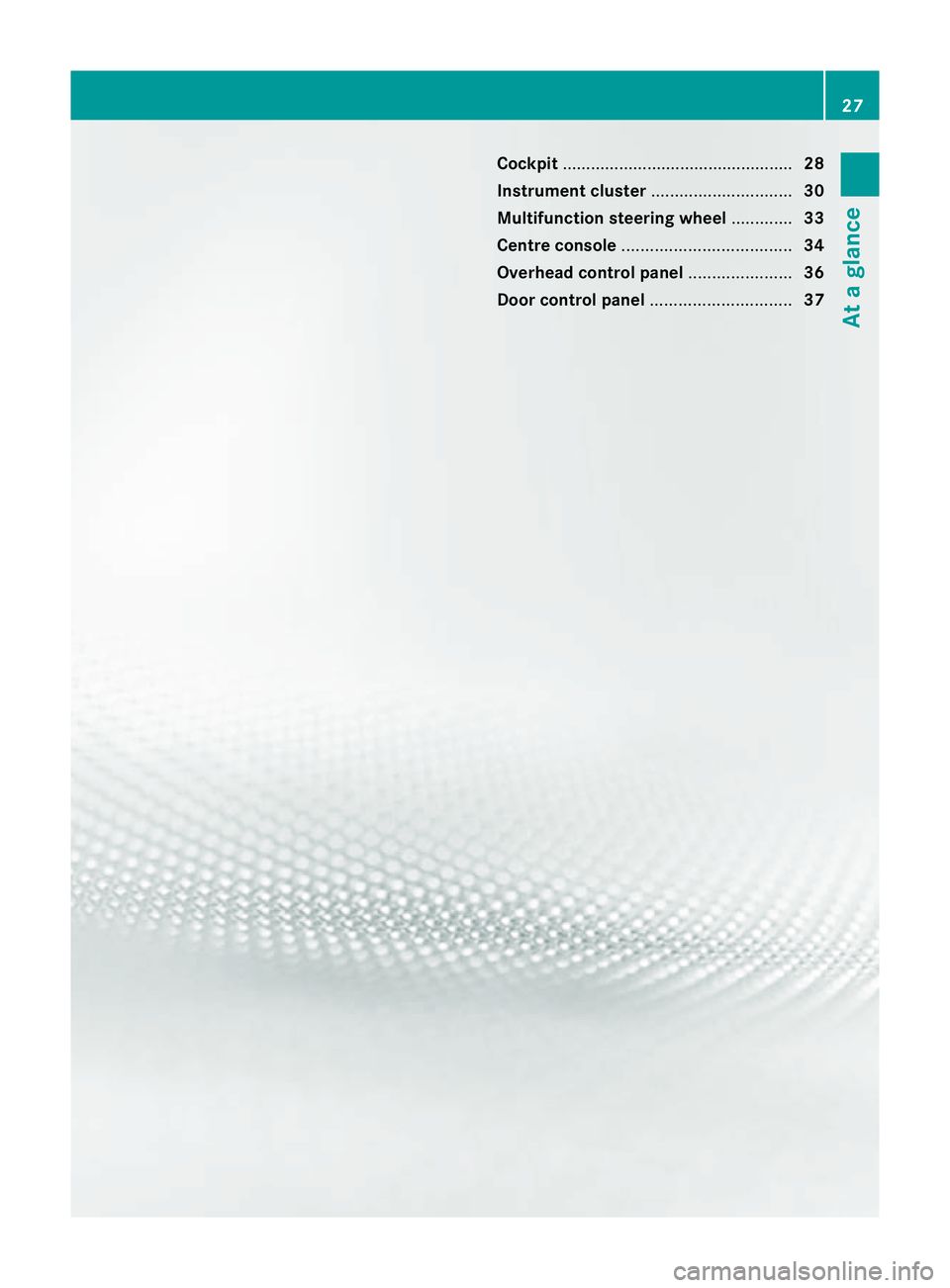
Cockpit
................................................. 28
Instrumen tcluster .............................. 30
Multifunction steering wheel .............33
Centre console .................................... 34
Overhea dcontrol panel ...................... 36
Door control panel .............................. 37 27At a glance
Page 31 of 389
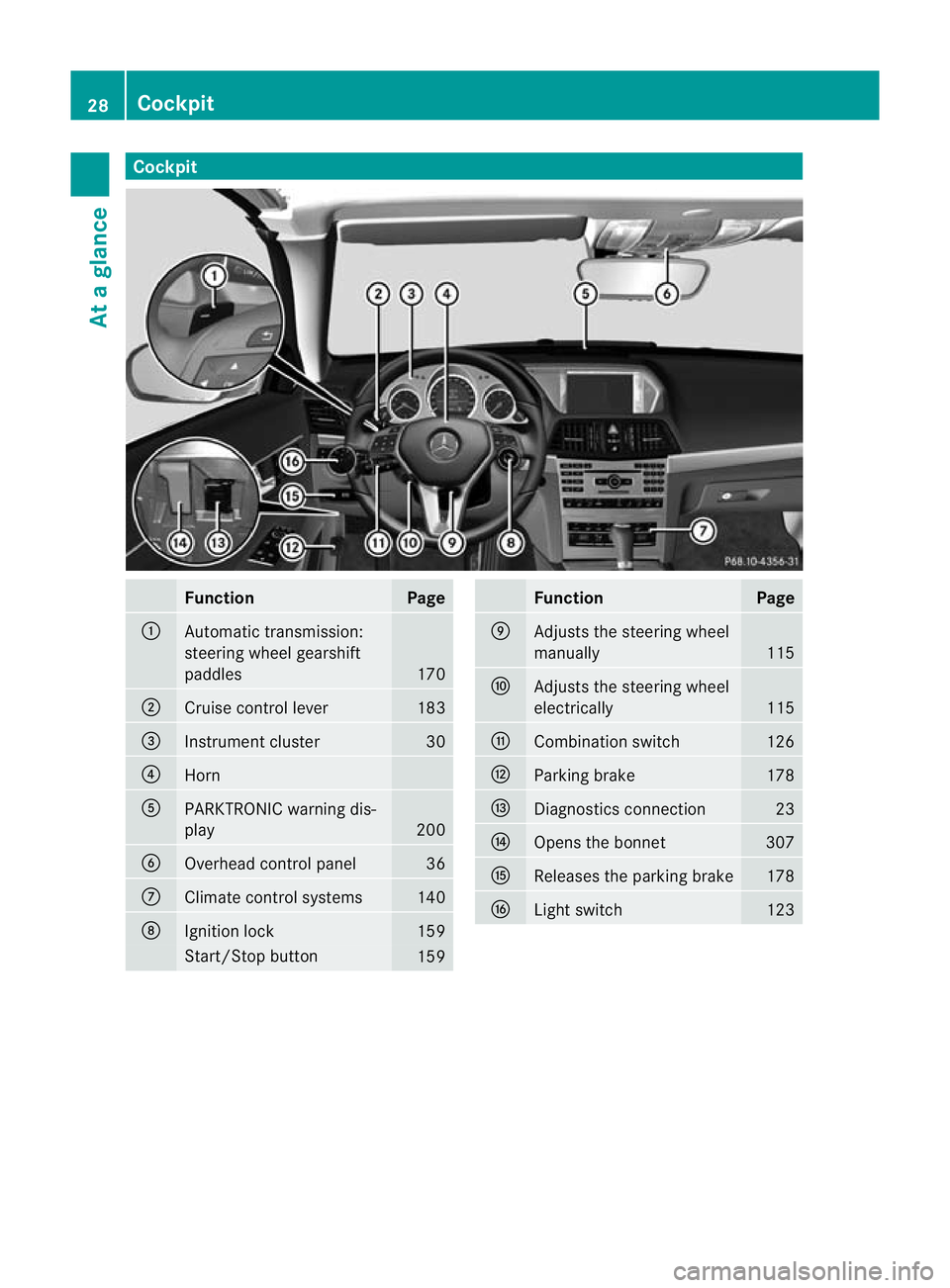
Cockpit
Function Page
:
Automatic transmission:
steering wheel gearshift
paddles
170
;
Cruise control lever 183
=
Instrument cluster 30
?
Horn
A
PARKTRONIC warning dis-
play
200
B
Overhead control panel 36
C
Climate control systems 140
D
Ignition lock 159
Start/Stop button
159 Function Page
E
Adjusts the steering wheel
manually 115
F
Adjusts the steering wheel
electrically 115
G
Combination switch 126
H
Parking brake 178
I
Diagnostics connection 23
J
Opens the bonnet 307
K
Releases the parking brake 178
L
Ligh
tswitch 12328
CockpitAt a glance
Page 32 of 389
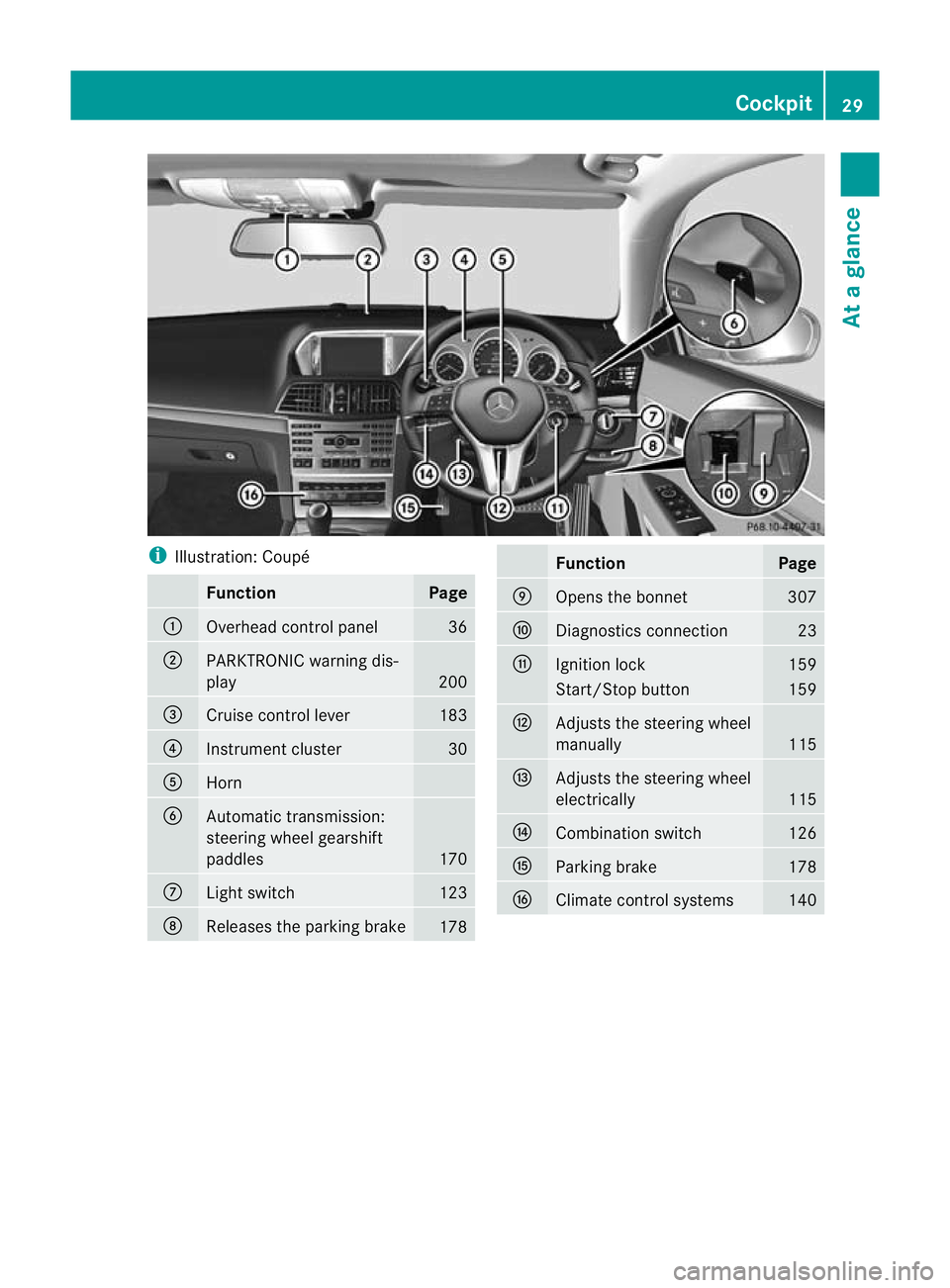
i
Illustration: Coupé Function Page
:
Overhead control panel 36
;
PARKTRONIC warning dis-
play
200
=
Cruise control lever 183
?
Instrument cluster 30
A
Horn
B
Automatic transmission:
steering wheel gearshift
paddles
170
C
Light switch 123
D
Releases the parking brake
178 Function Page
E
Opens the bonnet 307
F
Diagnostics connection 23
G
Ignition lock 159
Start/Stop button 159
H
Adjusts the steering wheel
manually
115
I
Adjusts the steering wheel
electrically
115
J
Combination switch 126
K
Parking brake 178
L
Climate control systems 140Cockpit
29At a glance
Page 36 of 389
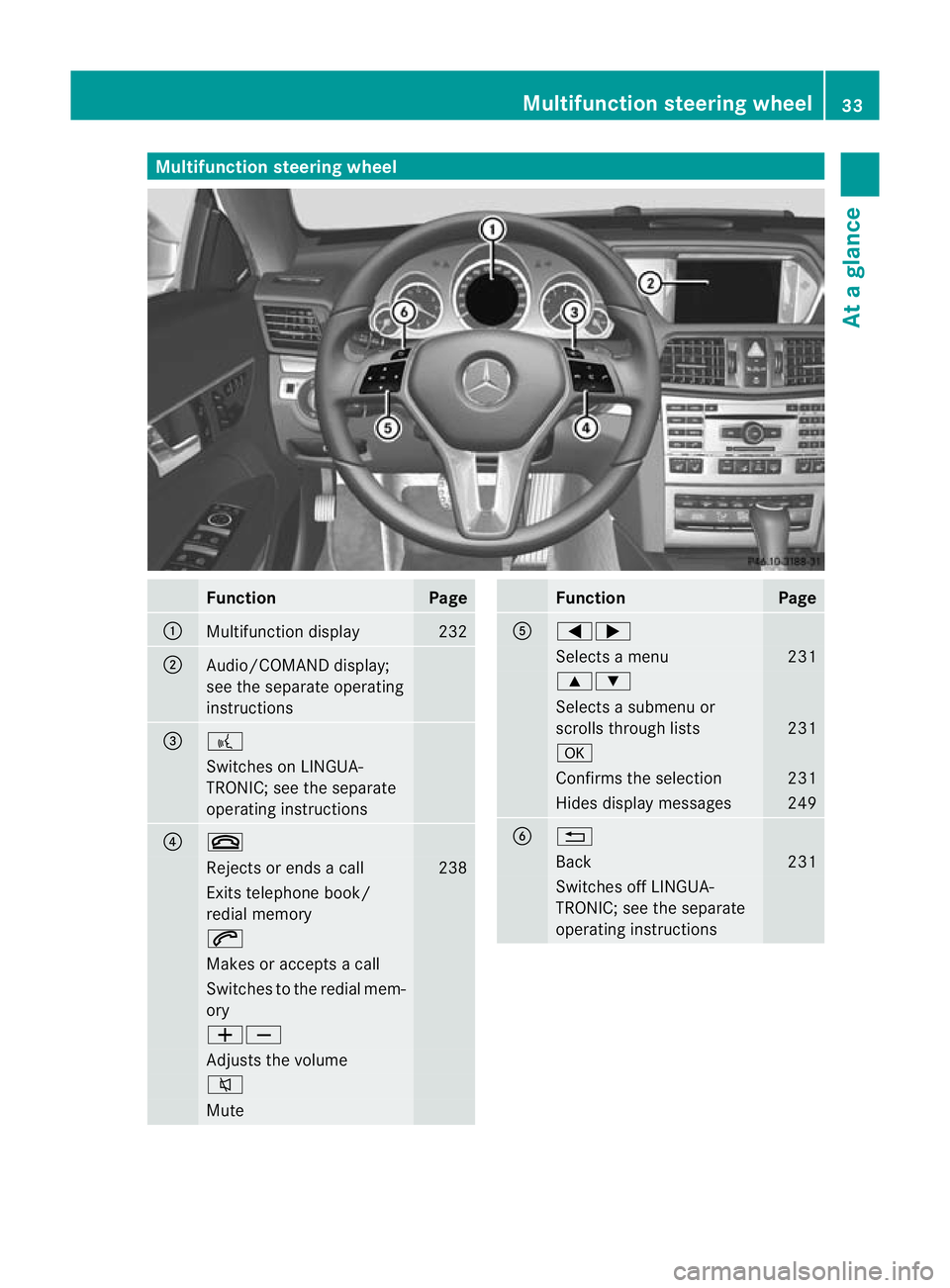
Multifunction steering wheel
Function Page
:
Multifunction display 232
;
Audio/COMAND display;
see the separate operating
instructions
=
?
Switches on LINGUA-
TRONIC; see the separate
operating instructions
?
~
Rejects or ends a call 238
Exits telephone book/
redial memory
6
Makes or accepts a call
Switches to the redial mem-
ory
WX
Adjusts the volume
8
Mute Function Page
A
=;
Selects a menu 231
9:
Selects a submenu or
scrolls through lists
231
a
Confirms the selection 231
Hides display messages 249
B
%
Back 231
Switches off LINGUA-
TRONIC; see the separate
operating instructionsMultifunction steering wheel
33At a glance
Page 40 of 389
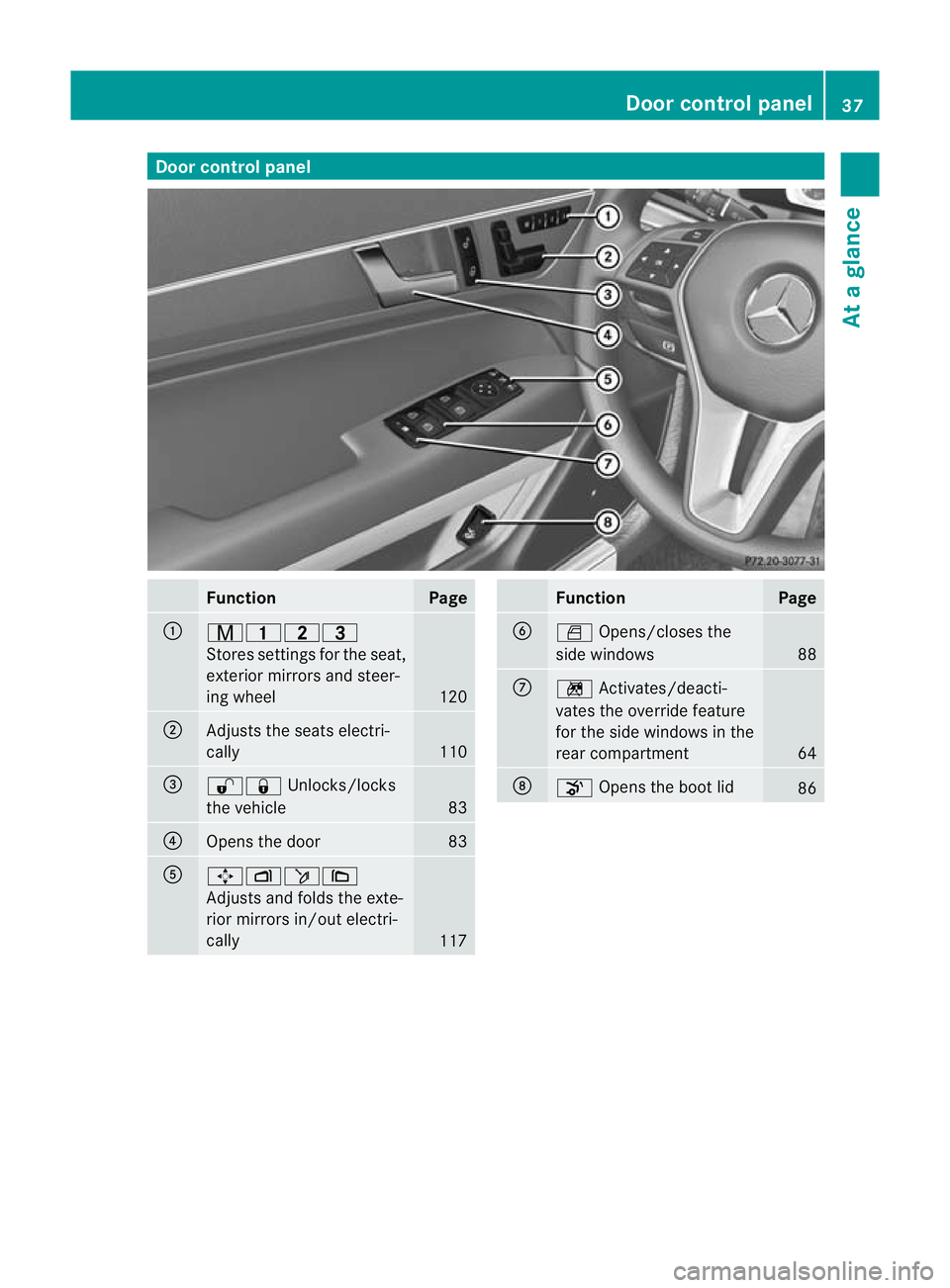
Door control panel
Function Page
:
r45=
Stores settings fo
rthe seat,
exterior mirrors and steer-
ing wheel 120
;
Adjusts the seats electri-
cally
110
=
%&
Unlocks/locks
the vehicle 83
?
Opens the door 83
A
7Zö\
Adjusts and folds the exte-
rior mirrors in/out electri-
cally
117 Function Page
B
W
Opens/closes the
side windows 88
C
n
Activates/deacti-
vates the override feature
for the side windows in the
rear compartment 64
D
o
Opens the boot lid 86Doorc
ontrol panel
37At a glance
Page 44 of 389

To ensure that the restraint systems can
deliver their full potential protection, make
sure that:
R the seat and head restraint are adjusted
properly (Y page 108).
R the seat belt has been fastened properly
(Y page 49).
R the airbags can inflate unrestricted if
deployed (Y page 42).
R the steering wheel is adjusted properly
(Y page 115).
R the restraint systems have not been modi-
fied.
An airbag increases the protection of vehicle
occupants wearing a seat belt. However, air-
bags are only an additional restraint system
which complements, but does not replace,
the seat belt. All vehicle occupants must wear
their seat belt correctly at all times, even if
the vehicle is equipped with airbags. The air-
bags are not deployed in all types of acci-
dents .For example, if the protective capacity
of correctly fastened seat belts is not
increased by deploying the airbags, the air-
bags will not deploy.
Airbag deployment only provides increased
protection if the seat belt is worn correctly.
First, the seat belt helps to keep the vehicle
occupant in the best position in relation to the
airbag. Second, in a head-on collision, for
example, the seat belt prevents the vehicle
occupant from being propelled towards the
point of impact. SRS (Supplemental Restraint System)
Introduction SRS consists of:
R
the 6 SRS warning lamp
R airbags
R the airbag control unit with crash sensors
R belt tensioners
R belt force limiters SRS reduces the risk of occupants coming
into contact with the vehicle's interior in the
event of an accident. It can also reduce the
forces to which occupant
sare subjected dur-
ing an accident.
SRS warning lamp G
WARNING
If SRS is malfunctioning, individual systems
may be triggered unintentionally or might not
be triggered in the event of an accident with
a high rate of vehicle deceleration.
A malfunction has occurred if:
R the 6 SRS warning lamp does not light
up when the ignitio nis switched on.
R the engine is running and the 6SRS
warning lamp does not go out after a few
seconds.
R the engine is running and the 6SRS
warning lamp lights up again.
In this case, have SRS checked immediately
at a qualified specialist workshop.
SRS functions are checked regularly when
you switch on the ignition and when the
engine is running. Therefore, malfunctions
can be detected in good time.
The 6 SRS warning lamp in the instrument
cluster lights up when the ignition is switched
on. It goes out no later than a few seconds
after the engine is started.
Triggering of belt tensioners, belt force
limiters and airbags During the first stage of a collision, the airbag
control unit evaluates important physical
data relating to vehicle deceleration or accel-
eration, such as:
R
duration
R direction
R magnitude
Based on the evaluation of this data, the air-
bag control unit pre-emptively triggers the
belt tensioners in the first stage. Occupant safety
41Safety Z
Page 46 of 389

R
move the front-passenger seat as far back
as possible. This is especially important if
you have secured a child in a child restraint
system on the front-passenger seat.
R vehicle occupants –inparticular, children
–m ust no tlean their heads in the area of
the window where:
- Coupé: the sidebag/windowbag
deploys.
- Cabriolet: the sidebag/headbag
deploys.
R rearward-facing child restraint systems
must not be fitted to the front-passenger
seat unless the front-passenger airbag has
been disabled. On the front-passenger
seat, the front-passenger airbag is disabled
if a child restraint system with a trans-
ponder for automatic child seat recognition
is fitted to the front-passenger seat in a
vehicle equipped with automatic child seat
recognition. The 4PASSENGER AIRBAG
OFF indicator lamp must be continuously
lit.
If the front-passenger seat of your vehicle
does not have automatic child seat recog-
nition, or your rearward-facing child
restraint system does not have a trans-
ponder for automatic child seat recogni-
tion, children must be secured in a child
restraint system on a suitable seat in the
rear. Secure children in a child restraint
system on a suitable rear seat. If you secure
a forward-facing child restraint system to
the front-passenger seat, you must move
the front-passenger seat as far back as pos-
sible.
R make sure there are no heavy or sharp-
edged objects in the pockets of clothing.
R do not lean forwards, e.g. over the cover of
the driver's/front-passenger front airbag,
particularly when the vehicle is in motion.
R do not put your feet on the dashboard.
R only hold the steering wheel on the outside.
This allows the airbag to be fully deployed.
You could be injured if the airbag is deployed and you are holding the inside of
the steering wheel.
R do not lean on the doors/rear sidewalls
from the inside.
R make sure that there are no people, ani-
mals or objects between the vehicle occu-
pants and the area where the airbags are
deployed.
R do not place any objects between the seat
backrest and the door.
R do not hang any hard objects, e.g. coat
hangers, on the grab handles or coat hooks.
R do not attach accessories such as cuphold-
ers to the doors/rear sidewalls.
It is not possible to rule out a risk of injury
being caused by an airbag, due to the high
speed at which the airbag must be deployed. G
WARNING
Airbag functionality can only be assured if the
following parts are not covered and no badges
or stickers are attached to them:
R padded steering wheel boss
R kneebag cover below the steering column
R front-passenger airbag cover
R outer side of fron tseat bolsters
R side trim next to the rear seat backrest
R Cabriolet: door trim G
WARNING
When an airbag deploys, a small amount of
powder is released. The powder may cause
short-term breathing difficulties to persons
suffering from asthma or other pulmonary
conditions.
In order to prevent potential breathing diffi-
culties, you should leave the vehicle as soon
as it is safe to do so. You can also open the
window to allow fresh air to enter the vehicle
interior. The powder does not constitute a
health hazard and does not indicate that there
is a fire in the vehicle. Occupant safety
43Safety Z